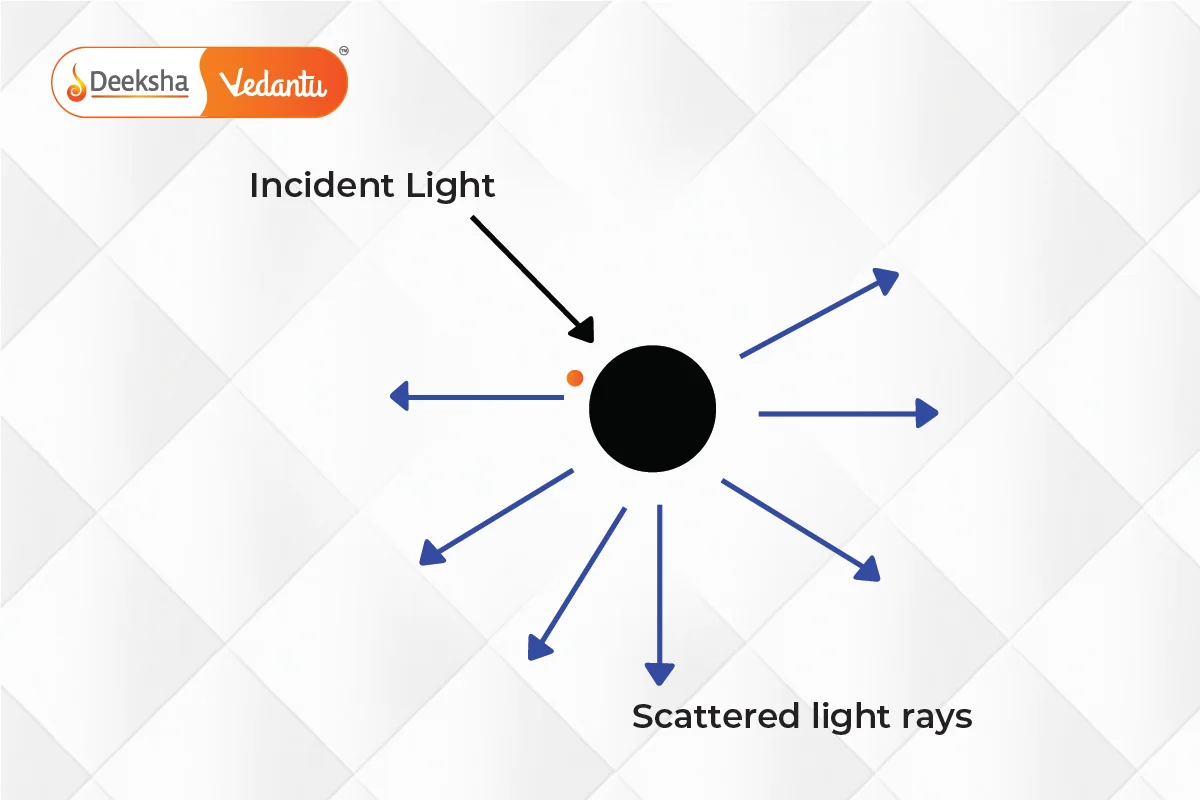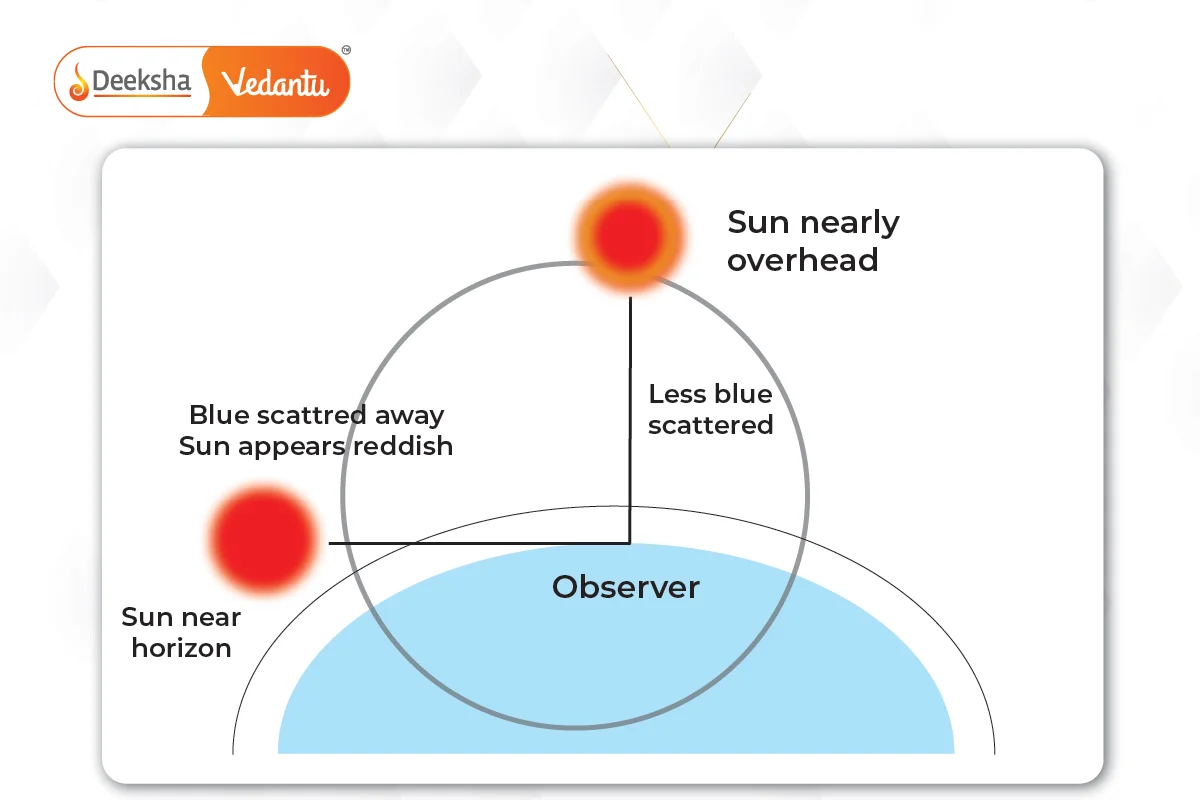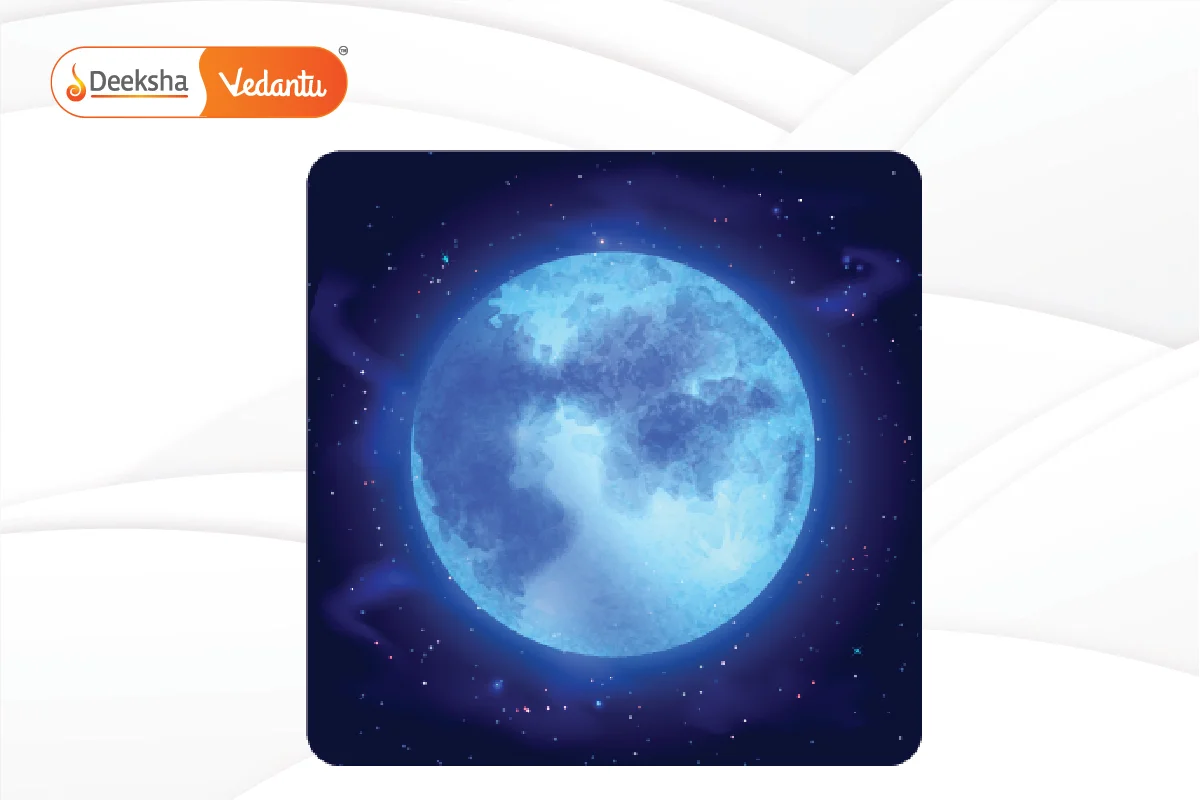Introduction
Scattering of light is a phenomenon where light rays change direction after interacting with particles, molecules, or irregularities within a medium. Unlike reflection or refraction, where light is redirected in specific predictable ways, scattering disperses light in multiple directions. This fundamental concept helps explain various natural phenomena like the blue color of the sky, the reddish-orange appearance of the Sun at sunrise and sunset, and the Tyndall effect seen in colloidal mixtures.

What is Scattering of Light?
When light travels through a medium such as the Earth’s atmosphere, it interacts with particles like gas molecules, dust, water droplets, or other suspended particles. These interactions cause the light to deviate from its original path, spreading out in different directions. This process is called scattering.
Scattering happens because particles in the atmosphere (or another medium) disturb the electromagnetic waves that constitute light, redirecting them randomly. The amount and direction of scattering depend on the wavelength of the light and the size of the particles causing the scattering.
Types of Scattering:
1. Rayleigh Scattering:
Rayleigh scattering occurs when the particles causing the scattering are much smaller than the wavelength of the light. It is the most common form of scattering in the Earth’s atmosphere and is responsible for the blue color of the sky and the reddish appearance of the Sun during sunrise and sunset.
- Characteristics: Rayleigh scattering is more effective at shorter wavelengths (such as blue and violet light). The intensity of scattering is inversely proportional to the fourth power of the wavelength, which is mathematically expressed as:
- This means shorter wavelengths (like blue) scatter more than longer wavelengths (like red).
2. Mie Scattering:
Mie scattering occurs when the size of the scattering particles is comparable to the wavelength of light. It usually happens with larger particles like dust, pollen, smoke, or water droplets. Unlike Rayleigh scattering, Mie scattering is not highly wavelength-dependent, meaning it affects all wavelengths of light more or less equally, leading to white or gray light scattering.
- Examples: Mie scattering explains why clouds, which consist of water droplets, appear white or gray. It also plays a role in haze and smog.
3. Tyndall Effect:
The Tyndall effect is a special case of scattering observed when light passes through a colloidal suspension (a mixture of small particles suspended in a medium). The light is scattered by the particles, making the light beam visible. This effect is commonly seen in colloids such as milk or fog.
- Examples: A beam of light passing through a room filled with dust or smoke becomes visible due to the Tyndall effect. Similarly, when light passes through a mixture of milk and water, the path of the light becomes visible because of the scattering by the fat particles in the milk.
4. Non-Selective Scattering:
Non-selective scattering occurs when the particles are much larger than the wavelength of light. This type of scattering affects all wavelengths equally, so no particular color is scattered more than another. This is why clouds appear white—the water droplets are large enough to scatter all wavelengths of light equally.
Factors Affecting Scattering:
The extent to which light is scattered depends on the following factors:
- Wavelength of Light:
- Shorter wavelengths (like blue and violet light) scatter more than longer wavelengths (like red and yellow light). This is why the sky appears blue—because blue light scatters more in the atmosphere than other colors.
- Size of Scattering Particles:
- Rayleigh scattering dominates when the particles are much smaller than the wavelength of light (like air molecules). Mie scattering becomes significant when the particles are similar in size to the wavelength of light (like dust or water droplets). Larger particles, such as those in clouds, cause non-selective scattering.
- Density of the Medium:
- The denser the medium, the more opportunities light has to interact with particles, leading to increased scattering. For instance, scattering is more pronounced in fog or smoke because of the high density of particles suspended in the air.
- Nature of the Medium:
- Different mediums have different refractive indices and compositions, affecting how light interacts with the particles within them. For example, light scatters differently in air, water, or glass due to differences in their molecular structures.
The Blue Color of the Sky
The blue color of the sky is one of the most well-known examples of Rayleigh scattering. When sunlight enters the Earth’s atmosphere, it interacts with the gas molecules and dust particles present. Since blue light has a shorter wavelength than red light, it scatters more efficiently across the sky.
Scientific Explanation:
- Sunlight contains all colors of light (white light), which are composed of different wavelengths. When sunlight passes through the atmosphere, shorter wavelengths (blue and violet) scatter more than longer wavelengths (red, orange, yellow).
- Even though violet light scatters more than blue light, we perceive the sky as blue because:
- Human eyes are more sensitive to blue light than violet light.
- Violet light is mostly absorbed by the upper layers of the atmosphere, particularly by ozone, which reduces the amount of violet light reaching our eyes.
Why is the Sky Blue?
- Short Wavelengths Scatter More: Blue light has a wavelength of about 450 nm, which is shorter than red light (approximately 700 nm). The shorter wavelength of blue light means it is scattered about 10 times more than red light in the atmosphere.
- Sensitivity of the Human Eye: Our eyes are more responsive to blue light than to violet light, contributing to the blue appearance of the sky.
The Reddening of the Sun at Sunrise and Sunset
During sunrise and sunset, the Sun appears red or orange instead of its usual white color. This change in color occurs because sunlight must travel through a much thicker layer of the Earth’s atmosphere at these times. The scattering of shorter wavelengths (blue and violet) removes most of the blue light from the path of the Sun’s rays, leaving the longer wavelengths (red and orange) to dominate the spectrum that reaches the observer’s eyes.
Scientific Explanation:
- Path of Light: When the Sun is near the horizon, its light must pass through a greater thickness of the Earth’s atmosphere compared to when it is overhead. This longer path scatters away most of the shorter wavelengths (blue and violet light) before they reach the observer, while the longer wavelengths (red, orange, and yellow) are less affected by scattering and pass through.
- Red and Orange Light: Since red and orange light have longer wavelengths, they are scattered less than blue and violet light. As a result, these colors become more dominant, giving the Sun its reddish appearance during sunrise and sunset.
Why is the Sun Red at Sunrise and Sunset?
- Longer Path Through Atmosphere: At sunrise and sunset, the Sun’s light travels through more atmosphere, scattering most of the blue and violet light out of view.
- Remaining Colors: The remaining red and orange light, which are less scattered, reach the observer, making the Sun appear red or orange.

The Tyndall Effect
The Tyndall effect is another example of the scattering of light, specifically observed in colloidal suspensions. A colloidal suspension is a mixture where tiny particles are dispersed throughout a medium. These particles scatter light, making the path of the light visible. The Tyndall effect is commonly seen when light passes through fog, smoke, or a mixture of milk and water.
Examples of the Tyndall Effect:
- Dust Particles in Sunlight: When sunlight enters a dark room through a window, the path of the light becomes visible because dust particles in the air scatter the light, making the beam of light visible.
- Fog and Mist: The water droplets suspended in fog or mist scatter light, which is why the beams of car headlights are visible in foggy conditions.
- Colloidal Suspensions: When milk is added to water, the fat particles in the milk scatter the light, causing the water to appear cloudy.
Why the Tyndall Effect Occurs:
- The particles in a colloidal suspension are small enough to remain suspended but large enough to scatter light. The scattering makes the light beam visible as it passes through the medium.
Applications of Scattering of Light
Scattering of light has numerous applications in both nature and technology. Some important applications include:
Blue Color of the Sky
As explained earlier, Rayleigh scattering is responsible for the blue color of the sky. This phenomenon occurs because shorter wavelengths (such as blue) are scattered more efficiently by the molecules in the atmosphere.
Red Color of the Sun at Sunrise and Sunset
During sunrise and sunset, sunlight passes through a thicker layer of the atmosphere, scattering shorter wavelengths and allowing the longer wavelengths (red and orange) to dominate, which is why the Sun appears red.
Fog Lights
Fog lights are typically yellow because yellow light has a longer wavelength than blue or white light. Since longer wavelengths scatter less, yellow light can penetrate fog and mist more effectively, improving visibility in such conditions.
Polarization Filters
Polarization filters used in cameras and sunglasses work by reducing the glare caused by scattered light. By allowing only light waves oscillating in a specific direction to pass through, these filters block scattered light, enhancing contrast and reducing reflections.
Astronomy and Atmospheric Studies
Scattering is critical in astronomy for understanding the appearance of stars, planets, and other celestial objects as observed from Earth. It also helps scientists study the Earth’s atmosphere by analyzing how light scatters due to gases, aerosols, and pollutants.
Real-Life Examples of Scattering of Light
Blue Moon
On rare occasions, the Moon can appear blue due to scattering. This phenomenon occurs when large amounts of particles (such as volcanic ash or smoke from forest fires) are present in the atmosphere. These particles scatter red and orange light, allowing blue light to dominate and giving the Moon a bluish hue.

White Appearance of Clouds
Clouds appear white because they contain water droplets or ice crystals that scatter all wavelengths of light almost equally, producing a white or gray appearance. This type of scattering is primarily Mie scattering, as the water droplets are larger than the wavelengths of visible light.

Glare from Road Surfaces
On hot days, the air near the road’s surface becomes heated, causing variations in the refractive index. This results in scattered light, producing a shimmering effect or mirage on the road. This is an example of Rayleigh scattering at work in a dynamic environment.
Practice Questions with Answers
Q1: What is scattering of light, and what are the factors that influence it?
- Answer: Scattering of light is the redirection of light rays in different directions when they interact with particles or molecules in a medium. The factors that influence scattering include the wavelength of light (shorter wavelengths scatter more) and the size of the scattering particles (smaller particles lead to Rayleigh scattering, while larger particles lead to Mie scattering).
Q2: Why does the sky appear blue?
- Answer: The sky appears blue due to Rayleigh scattering, where shorter wavelengths of light (such as blue) scatter more efficiently than longer wavelengths (such as red). The scattered blue light reaches our eyes from all directions, making the sky appear blue.
Q3: Why is the Sun red at sunrise and sunset?
- Answer: The Sun appears red at sunrise and sunset because its light must travel through a thicker layer of the atmosphere, which scatters shorter wavelengths (blue and violet) out of view. The remaining longer wavelengths (red and orange) dominate, giving the Sun its reddish hue.
Q4: What is the Tyndall effect, and where can it be observed?
- Answer: The Tyndall effect is the scattering of light by particles in a colloidal suspension, making the path of the light visible. It can be observed in examples such as sunlight passing through a dusty room, fog, or a mixture of milk and water.
Q5: How does scattering explain the white appearance of clouds?
- Answer: Clouds appear white because the water droplets inside them are large enough to scatter all wavelengths of visible light equally. This scattering of all colors results in the white or gray appearance of clouds.
FAQs
Yes, scattering can occur in any medium where light interacts with particles or irregularities. For example, scattering occurs in colloidal suspensions (like milk in water), glass (if it contains impurities), and even in water bodies with suspended particles.
Scattering can reduce visibility by causing light to be redirected in multiple directions. This is why fog, smog, or haze can make it difficult to see distant objects—light from these objects is scattered before reaching the observer.
Fog lights are typically yellow because longer wavelengths (like yellow light) scatter less than shorter wavelengths (like blue light). This allows yellow light to penetrate fog more effectively, improving visibility in foggy conditions.
At noon, the Sun is overhead, and its light travels through a shorter path in the atmosphere. As a result, all wavelengths of light scatter less, and the Sun appears white because all colors of light are reaching the observer in nearly equal amounts.
Although violet light scatters more than blue light, the sky does not appear violet because the human eye is less sensitive to violet light. Additionally, much of the violet light is absorbed by the upper atmosphere, making blue light more dominant.
Related Topics
- Resistance Of A System Of Resistors
- Protection Against Earthquake
- Defects Of Vision And Their Correction
- The Human Eye
- P-N Junction
- Projectile Motion
- Refraction Of Light Through A Prism
- Magnetic Field And Field Lines
- Domestic Electric Circuits
- The Human Eye And The Colourful World
- Refraction Of Light
- Atmospheric Refraction
- Ohm’s Law
- Physics FAQs
- Magnetic Field Due To A Current – Carrying Conductor











Get Social